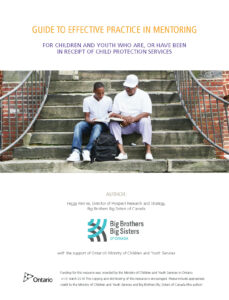GUIDE TO EFFECTIVE PRACTICE IN MENTORING
FOR CHILDREN AND YOUTH WHO ARE, OR HAVE BEEN
IN RECEIPT OF CHILD PROTECTION SERVICES
Author
Big Brothers Big Sisters of Canada
supported by
The Ministry of Children and Youth Services
| v1.0 March 2016 | ||
| The copying and distributing of this resource is encouraged. Please include appropriate credit to the Ministry of Children and Youth Services and Big Brothers Big Sisters of Canada (the author).
Funding for this resource was provided by the Ministry of Children and Youth Services in Ontario |
The field of mentoring has grown substantially over the past two decades generating different types of approaches or models, within a variety of settings and with service to increasingly high risk youth. Although innovation in and expansion of youth mentoring programs are positive trends, it is imperative that structured mentoring programs are developed and implemented using consistent standards supported by research.
Mentoring, at its core, is a simple concept. However, “believing that mentoring is so easy and so inexpensive that anyone can do it” does a disservice to everyone involved in a mentoring program. (Effective Strategies for Providing Quality Youth Mentoring in Schools and Communities, 2007) Running an effective mentoring program is not easy, and there are many nuances and programmatic details that can have a big impact on outcomes for youth. Furthermore, recent mentoring research points to potentially harmful consequences of short-lived mentoring relationships; a hallmark of programs that are not well designed. This guide is intended to provide you with research, best practices and information to support the development of meaningful, effective mentoring programs.

